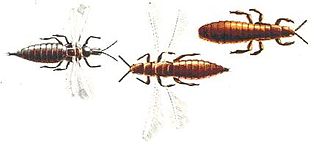
Thrips are minute, slender insects with fringed wings and unique asymmetrical mouthparts. Different thrips species feed mostly on plants by puncturing and sucking up the contents, although a few are predators. Entomologists have described approximately 6,000 species. They fly only weakly and their feathery wings are unsuitable for conventional flight; instead, thrips exploit an unusual mechanism, clap and fling, to create lift using an unsteady circulation pattern with transient vortices near the wings.
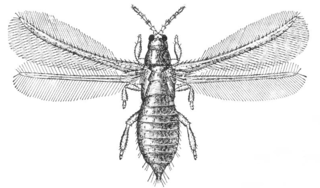
The Thripidae are the most speciose family of thrips, with over 290 genera representing just over two thousand species. They can be distinguished from other thrips by a saw-like ovipositor curving downwards, narrow wings with two veins, and antennae of six to ten antennomeres with stiletto-like forked sense cones on antennal segments III and IV.
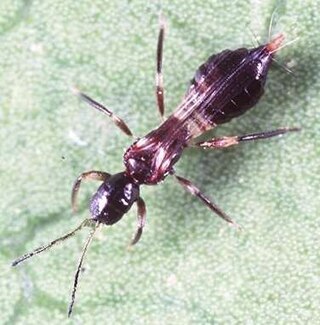
Franklinothrips is a genus of thrips with pantropical distribution.
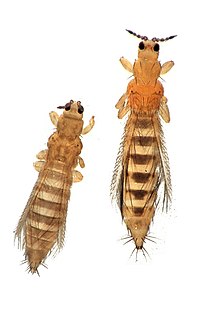
Thrips is a genus of insect in the order Thysanoptera.
Akthethrips is a genus of thrips in the family Phlaeothripidae, first described by Laurence Mound in 1970. There is just one species in this genus, Akthethrips strobus, which is found in New South Wales and South Australia, living on the foliage of Casuarina glauca, and Casuarina pauper.
Anaglyptothrips is a genus of thrips in the family Phlaeothripidae, first described by Laurence Mound and Palmer in 1983. There is only one species known in this genus, Anaglyptothrips dugdalei, which was described from a specimen collected in New Zealand. However it is also found in New South Wales and Queensland.
Apostlethrips is a genus of thrips in the family Phlaeothripidae, first described by Laurence Mound and Kamb Minaei in 2006. The type species is Apostlethrips apostus. The members of this genus are found only in Australia, in the Northern Territory and Western Australia, at the base of grass tussocks where they are believed to feed on fungal hyphae.
Bactrothrips is a genus of thrips in the family Phlaeothripidae, first described by Heinrich Hugo Karny in 1912. In, Mound and Tree synonymised the genus, Lasiothrips, with Bactrothrips
Brakothrips is a genus of thrips in the family Phlaeothripidae, first described by Crespi, Morris and Mound in 2004. The type species is Brakothrips gillesi. Insects in this genus are found only in Australia, living under the splitting bark of young branches of Acacias.
Crespithrips is a genus of thrips in the family Phlaeothripidae, which was first described by Laurence Alfred Mound and David C. Morris in 2000. The type species is Crespithrips enigmaticus.
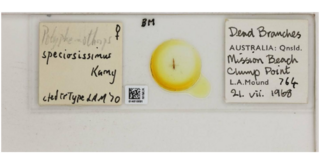
Holothrips is a genus of thrips in the family Phlaeothripidae, first described in 1911 by Heinrich Hugo Karny. The type species is Holothrips ingens.
Koptothrips is a genus of thrips in the family Phlaeothripidae, first described by Richard Siddoway Bagnall in 1929.
Octurothrips is a genus of thrips in the family Phlaeothripidae, first described by Hermann Priesner in 1931. There is just one species in this genus: Octurothrips pulcher.
Senithrips is a genus of thrips in the family Phlaeothripidae, found in Western Australia, and first described by Laurence Mound and Kambiz Minaei in 2006. The genus contains just one species, Senithrips psomus.
Xaniothrips is a genus of thrips in the family Phlaeothripidae, which was first described by Laurence Mound in 1971. The type species is Xaniothrips xantes.
Laurence Alfred Mound is an entomologist, who works mostly on the biology and systematics of Thysanoptera (thrips), an area in which he is considered a world authority.

Holothrips speciossissimus is a species of thrips in the family Phlaeothripidae, first described in 1920 as Nesothrips speciossissimus by Heinrich Hugo Karny, from a specimen collected at Cedar Creek in Queensland.
Holothrips circulus is a species of thrips in the Phlaeothripinae subfamily, first described in 2014 by Laurence Mound and Desley Tree, known only from its type locality, Springbrook, Queensland.
Holothrips eurytis is a species of thrips in the Phlaeothripinae subfamily, first described in 2014 by Laurence Mound and Desley Tree. This species is found in New South Wales, the ACT and Queensland, and is endemic to Australia
Holothrips federicae is a species of thrips in the Phlaeothripinae subfamily, first described in 2014 by Laurence Mound and Desley Tree. This trhips is found in both New South Wales and Queensland, and is endemic to Australia.




